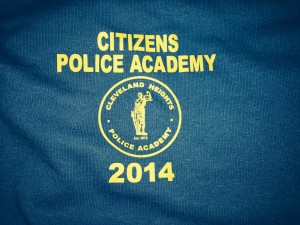Background: The Cleveland Heights Police Department has launched a Citizens Police Academy for members of the community who are interested in learning more about how the police department operates. The first course runs 6-9 p.m. on Monday and Tuesday evenings, for seven weeks beginning Aug. 11 and ending Sept. 30, 2014. This blog post is one of a series about my experience in the program. Click here for the full series.
 It’s easy to forget that police officers have the same range of reactions as the rest of us to crime, poverty, drugs, violence, squalor, hopelessness.
It’s easy to forget that police officers have the same range of reactions as the rest of us to crime, poverty, drugs, violence, squalor, hopelessness.
For many people, just the highlights that make the news provide all the evidence needed to conclude the world is coming to an end.
Police officers see a lot more than the highlights.
When responding to a domestic violence call, the officer’s priorities are to stabilize the situation, calm down the parties, separate them if possible and investigate whether an arrest is necessary. The dispassion this requires doesn’t mean they’re blind to the trauma that someone has experienced at the hands of a loved one.
When an under-supervised kid with a dysfunctional home gets nabbed for theft, fighting or buying drugs, the police are required to make an arrest. But it doesn’t mean they’re unaware a young life may be circling the drain.
When the news brings me down, I exercise my the ability to tune it out. Police officers don’t have that luxury.
With more than 20 years on the force, CHPD Inv. Falisa Berry thinks about this a lot. She’s working on a Ph.D. in psychology, and her thesis is on “vicarious trauma” in police officers – how the suffering of other people affects them.
To hear Berry discuss her own frequent encounters with domestic violence over the years is to understand she didn’t pull this thesis topic out of thin air.
But Berry is also head of the city’s Juvenile Diversion Program, which means she’s doing something most police officers can’t; she’s getting involved with people before the worst happens.
The Juvenile Diversion Program only began this January. It identifies first-time, non-violent offenders, 17 or younger, and tries to help them turn around before they get into more serious trouble.
The program runs in cooperation with Cuyahoga County Juvenile Court, which identifies candidates and essentially turns them over to the care of their home town.
Officially, the kids’ cases move back to the Cleveland Heights court system, where sanctions include a mentoring program that Berry has developed. It involves group sessions, counseling, supervision and community service.
“These are good kids who made bad choices,” Berry said. Because kids in the program are minors, parental permission is required for participation; parental involvement is not. “I try not to focus on the parents; they’ve had their chance.”
When Berry spoke to us at the Citizens Police Academy, she brought D., who had agreed to talk about her experience in the program. D. talks and dresses like any other high school girl; she has a bright smile and a soft voice.
She was arrested after joining a fight at the public library.
“Most people think of it like a punishment, but it’s not,” D. said of the Juvenile Diversion Program. “Mostly we talk about communication and long-term goals and how to deal with other people and solve problem.” Looking at Berry, D. added: “She talks straight to us. She tells it like it is.”
“Has it affected how you’re doing in school?” someone asked.
D. hesitated. “Well… I wasn’t doing that bad before…”
“Yes you were,” Berry interrupted. D. smiled and went silent, acknowledging the sudden example of straight talk. “But she’s getting straight A’s right now,” Berry said.
Currently the program is full, with 40 kids actively involved, another 15 waiting for a spot to open and no shortage of prospects in the pipeline. Berry acknowledged that “not everyone is going to make it. Some of these kids are really damaged. Most of them don’t have positive role models. Maybe I can reach some of them. I hope I can.”
As we all know, Cleveland Heights has plenty of kids who need more supervision, more direction, more people to invest in them. This is a symptom of poverty, and with more than half the students in the Cleveland Hts.-University Hts. City School District qualifying for the federal free lunch program, we have more than our share of poverty here.
Is it the job of the police department to do social work? Perhaps not. But if it doesn’t go after kids before they get ruined, it’ll be chasing them down later. More trauma.
I don’t know much about the people who have been charged in the homicide of Arrion Smiley earlier this month or Jim Brennan this summer. But I don’t think I’m on thin ice to declare them lost causes who just need to be put away.
But not very long ago, they were kids too. Maybe funny kids, with a sense of humor and a warm smile. At one point, there was still hope for each of them.



Leave a Reply